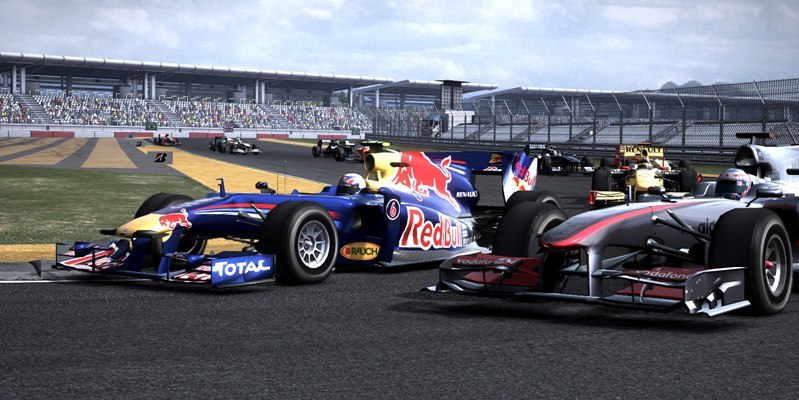Codemasters follows up last year’s Wii title, which was a lot of fun and looked beautiful. The developer has tried to get close as it can to a metallic, lean simulation of Formula 1 as is possible today, but does it have a soul under the hood?
To begin with an admission, I’ve always tended towards Mario Kart, Gotham Street Racing and F-Zero, and away from 1000 Miglia, F1 ’97 and TOCA Touring Car Championship. As someone who didn’t learn to drive until I was forced to, the notion of making gear changes and braking into corners left me cold. This game, then, was a real challenge.
A decade-long obsession with stress testing, tuning and graffiti has been roughly analogous to the period in which it’s been hard to get excited about “proper” racing titles. The bloat factor that made F1 intractably dull had infected video games seeking to simulate everything that was so wrong about the sport, along with what was still all right.
It hasn’t helped that any franchised sport games have slipped into the mire of generic licensed music, endless menus and rear wheel perspective adverts. I won’t be happy until everyone drives to Kraftwerk, but this seems as unrealistic as the standard synth rock and trance the racing game player is always saddled with. It seems unfair to make an initial criticism of F1 2010 as being on the same track with its dull, dating music. However, it helps to establish the car in its class, so it’s easier to see where Codemasters has overhauled its engine.Trimming the fatJust as F1 itself is at its most competitive in many years, F1 2010 just might herald a return to sims of motor sport rather than of the sport’s fatty and insincere highlights package. Just like the sublime Blur did for bumper racers, this game made me want to keep an eye out for developments in its genre. While the differences in car performance are often so slight as to be in the realms of the boy racer, I found the game’s feel to be immensely rewarding.
While one season ends with a measly finish in the drivers’ championship, the next can see the player emerge as the winner. Consistency is the key, as is waiting for the very gratifying R&D segments, which shave further seconds off laps and catapult a driver up the rankings. The compulsory time trials to poll for career races are as important as the races themselves. Without good performances in these, there is no chance any driver will get into the points. Leading from the back is not an option: the edge between the cars is so slight.
The front end is a little dated, but is clean and easy to navigate. Some options, bars and sliders can be elided through having short conversations with a manufacturer’s engineers ahead of race day. This removes one big barrier to the Sunday racer such as myself, who will more likely be dazzled by the weather turning halfway through an endurance race, or the grit accumulating on the car in front’s tyres. Some of the non-play areas are a little repetitive, but the track modelling and again that weather! set the benchmark very high.Money talksOne of F1’s least sim-like aspects may actually encompass one of the sport’s failings best, in that the detached and option-less press interviews are very close to the mark. Drivers are a little disappointed or excited at their results. In a billion-dollar industry like motor racing, there is no room for mavericks who can jeopardise a team’s season with a misjudged comment. This aspect of the game is probably unintentional but I found it funny.
I usually draw a distinction between the player twiddling the controller and the character, through which they do all the vicarious prize-winning, but it’s not so important here: the adulation and slightly smug feeling of beating two-dimensional rich kids often transcends that sort of distance.
A full-fledged simulation, then, showcases the delights of speed and the monotony of an F1 driver’s calendar with equal honesty. As such, a frequent driving game player’s time will not be wasted here. Having said that, it’s an uphill slog getting anywhere in the rankings and doesn’t suit an arcade roustabout, but this is not Codemasters’ intention. Were a player previously comfortable with spending hours tinkering with graffiti and drift on a street car game, they’ll find F1 2010 a much more rewarding experience, where “first” means less than a flawless lap.
